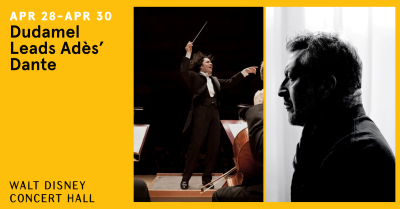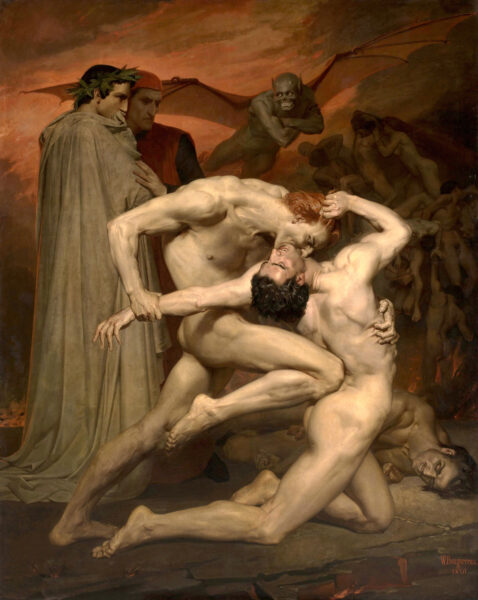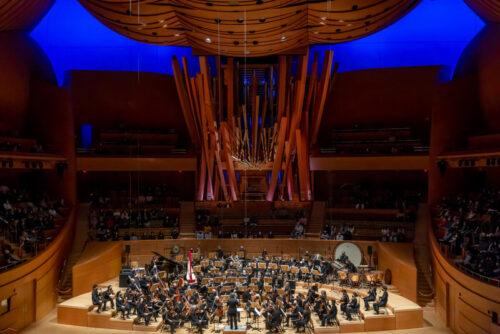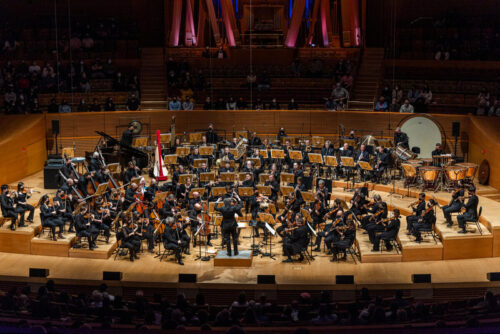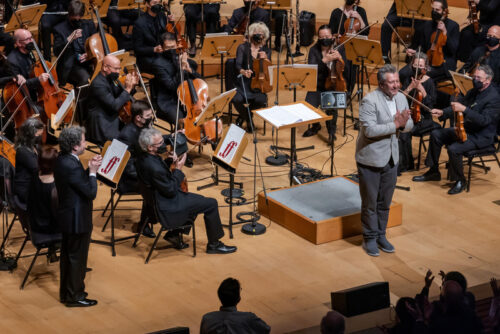DO NOT ABANDON HOPE;
THIS GENERATION’S STRAVINSKY HAS ARRIVED
I have great tidings, for English composer Thomas Adès has bestowed on us what is easily one of the greatest works of the twenty-first century. Under the aegis of its Gen X festival, LA Phil premiered his huge symphonic fantasia, Dante, last weekend at Disney Hall, an adventure as intoxicating as the poem which inspired it, Dante Alighieri’s The Divine Comedy. This masterpiece of Western literature, written in the early 14th century (between 1303 and 1321), describes a journey to the borders of the three super-terrestrial realms that are Hell, Purgatory and Paradise. Dante, who plays himself in the story, is guilty of the sin of lust and ends up in Hell. There, he meets the soul of the poet Virgil, a famous writer who really existed during the Roman Republic, around 50 BC. Virgil offers to accompany him through Hell and Purgatory, so that he can reach Paradise and avoid the many obstacles and fearsome creatures that will slip in his path. The two companions cross together the 9 circles of Hell, each one being dedicated to a particular sin. Through this dark journey, Dante and Virgil discover more or less famous protagonists –sometimes real, sometimes fictional.
Each of the 3 stages contains 33 cantos, and an introductory canto, bringing the total of the piece up to 100 cantos. These sections are so detailed that they have inspired many artists throughout the centuries, with painters trying to illustrate the strange scenes of this captivating epic. The painting above, used by LA Phil for promotion, is Dante and Virgil by William Bouguereau, painted in 1850 when the artist was 25 (it became in 2010 part of the permanent collection at Musée d’Orsay in Paris.) I daresay Adès’s new work is like this painting — thrilling, eerie, timeless, profound, muscular, and sexy as, well, hell.
The man doing the neck-biting is none other than Gianni Schicchi, a true-life 13th-century Italian knight who usurped the identity of a dead man in order to fraudulently claim his inheritance. Giacomo Puccini based his one-act comic opera on this trickster (who is wrestling with an alchemist and heretic named Capocchio in the painting). The poem has inspired other composers, including Giovanni Pacini, Enrique Granados, and Pyotr Tchaikovsky, but Adès’s is the first piece I know of that has taken on all of The Divine Comedy in three sections as individual journeys, albeit in a truncated form (I mean, who in their right mind will take on one hundred cantos?). The first section Inferno describes thirteen cantos (a nice, evil number), the second, Purgatorio, has seven, and the third is an envisioning of Paradiso (I consider each section a tone poem, while only the third is continuous). Franz Liszt wrote a single-movement sonata based on the canto “Inferno” and a romantic choral symphony based on Dante’s journey through Hell and Purgatory; these works highly inspired Adès, who even references Liszt in this 90-minute work.
The LA Phil commissioned “Inferno” and offered its World Premiere in May, 2019 with Gustavo Dudamel conducting. I loved it even more this time, and was relieved that the two newer pieces were just as exciting. The three pieces, by the way, are now a ballet, The Dante Project, which premiered last October at The Royal Ballet, Covent Garden, with Adès conducting and Wayne McGregor choreographing (“Inferno” was first shown as a standalone choreographic piece in L.A., also in 2019). While a full-length ballet sounds nothing short of wonderful, the chance to concentrate on the massive orchestra last Saturday night, with Dudamel again conducting, was astounding. It’s harder to prick up your ears to the music when watching ballet, so this opportunity was an unparalleled experience. It was also recorded, so when it is released I see another Grammy nod for the LA Phil.
This must be a beast to conduct, but you wouldn’t know it from a centered, excited, youthful Dudamel, who sometimes paused between movements and quickly segued to others. The score began foreboding, insistent, mystical, with bits of danse macabre and percussion on steroids. And this is just the first canto, “Abandon Hope.” (I was so entranced by the players that I never even noticed the supertitles indicating which piece we were hearing.) The second “The Selfish” just oozes Stravinsky, whether playful or somber, as we were treated to differentiations in tonality, meter, rhythm, stress and dissonance. The reeds, fluttering like pluckish birds, had no job as awesome as principal flutist Denis Bouriakov, who played such incredibly long passages and arpeggios throughout that it took real concentration just to figure out when he was breathing. Certainly oboes and clarinets were used a lot, but it seemed to me that the flutes did the yeoman’s work. The third passage, “The Ferryman”, had a sweeping, investigative, and adventurous feel to it, like Ben-Hur with blaring brass and marching timpani (the stalwart Joseph Pereira). And finally we have a score that showed off why Emmanuel Ceysson was chosen as the Phil’s principal harpist. Adès (who was in the house) showed off sterling orchestrations, too: The celesta, xylophone, and flutes were amazing together.
Speaking of orchestrations, the percussion section alone was worth the price of admission. Over 40 instruments were used in this section, and I can say I finally saw a gong drum used for the first time. But never did they sound like the atmospheric new music which evokes a sci-fi movie. Here, the pure adrenaline rush was nothing but adventure. I daresay that the great film composers — Korngold, Elmer Bernstein, Steiner, and more — were smiling from the heavens. A true delight arrived in “The Thieves”, which was the love child of Looney Tunes and Stravinsky’s Petrushka (which Dudamel is conducting on May 12 and 13). And in the second half of the program, I believe Stravinsky’s The Firebird was referenced.
The sensation that magic would continue came immediately after intermission with the first movement of Purgatorio. The winning combination of pianissimo reeds and percussion — and later brass sounding as if they were blowing out candles — created the sensation of a windy crevice in this most spiritual of the sections. Aiding that sensation were members of LA Master Chorale. First came pre-recorded singing in Hebrew from a lone male voice, which called to mind humans repenting and praying to God to save their souls from damnation for thousands of years. Later in Paradiso, a hidden choir of women — not unlike the end of Holst’s The Planets — ensured the journey ended in Elysium.
New Music reached an apotheosis this weekend, as it was both experimental and wholly accessible. As a listener, it’s simply not important to know exactly what is happening in the movements — just close your eyes and let Boris Allakhverdyan‘s luxurious clarinet solo, backed by the lightest tremolo from the strings, take you into a realm of heaven which words cannot describe. Paradise was very unconventional given the centuries of oratorios that have tried to replicate the Empyrean domain. The sensation was like floating in the universe. It was as if to say you may be in heaven, but hell is always nearby. Which is fine with me, because hell never sounded so good.
photos courtesy of LA Phil
DUDAMEL LEADS ADÈS’S “DANTE”
presented by LA Phil | Gustavo Dudamel, conductor
Walt Disney Concert Hall
reviewed Saturday April 30, 2022
for more info, call 323.850.2000 or visit LA Phil
